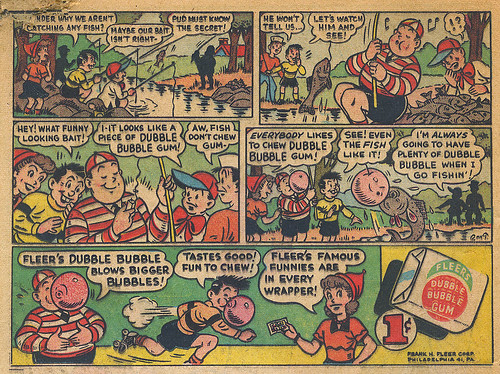Oh how I loved Dubble Bubble and Bazooka gum when I was growing up. A big wad of it stuck in my mouth, forever trying to blow big bubbles, ending up with it stuck in my hair, my mother telling me to hold still while she got it out (often with scissors).
The added bonus were the little tiny comics inside the wrapper. Now I probably couldn't read them without a magnifying glass.
And I wouldn't even think of trying to chew a big wad of bubble gum now. If I didn't pull a crown off, I'd most certainly send my TMJ into overdrive. Dubble Bubble would be for me nothing but trouble. And that makes me a little sad because I really did enjoy blowing those bubbles.
This image is again from the July-August 1951 Archie comic.
Click on image to see it larger.
And here's a little background about Dubble Bubble. Who knew it had an interesting history?
The Fleer Corporation, founded by Frank H. Fleer in 1885, was the first company to successfully manufacture bubblegum; it remained a family-owned enterprise until it was taken private in 1989.and
Fleer originally developed a bubblegum formulation called Blibber-Blubber in 1906. Unfortunately, while this gum was capable of being blown into bubbles, in other respects it was vastly inferior to regular chewing gum, and Blibber-Blubber was never marketed to the public. In 1928, Fleer employee Walter Diemer improved the Blibber-Blubber formulation to produce the first commercially successful bubblegum, Dubble Bubble. Its pink color set a tradition for nearly all bubble gums to follow. (SOURCE: Wikipedia)
Dubble Bubble is a brand of bubble gum invented in 1928 by Philadelphia-based Fleer. Walter E. Diemer — an accountant at Fleer — enjoyed experimenting with recipes during his free time. In an interview a few years before his death, he said, "It was an accident". In 1937, the gum went on the market nationally. It featured a comic strip that came with the gum starting in 1930, featuring twin brothers Dub and Bub. They were replaced by a new character named Pud in 1950.Dubble Bubble was distributed in military rations during World War II until 1942. Due to war efforts, latex and sugar became scarce, briefly putting a halt to bubble gum manufacturing in the U.S. By 1951, Fleer was again able to manufacture Dubble Bubble, and in 1954, the company began sponsoring bubble gum blowing contests, which grew in popularity and were eventually televised.Dubble Bubble was introduced as the first five-pack of gum in 1957, and began selling gumballs in 1999. Fleer eventually extended the line to apple, grape, cherry and watermelon flavors.When Concord Confections bought the Dubble Bubble name from Fleer in 1998, they did not use Fleer's original 1928 Dubble Bubble recipe, and comic strips were discontinued; Pud remained mascot. In August 2004, Tootsie Roll expanded its presence in the bubble gum category by acquiring Concord Confections. Today, Dubble Bubble continues to grow, with Tootsie adding product extensions like Dubble Bubble Mini Tubs and Halloween Combo packaged gumballs and expanding distribution globally. The gum is sold in 50 countries. (SOURCE: Wikipedia)













Is this FLEER as in Baseball cards?
ReplyDeleteYup.
ReplyDeleteI hated the gum that came in the cards. Seemed to be powdered and left a bitter taste in my mouth. ;o)
ReplyDeleteI could almost smell it as I was reading this post, which reminds me of a very creepy experience. Years ago I was in the San Francisco Public Library when I got the sense that someone was following me. I thought maybe I was imagining it, so I purposely went to different floors and areas in rapid succession. I was not imagining it - and I could smell him before I could see him, because he was chewing bubble gum.
ReplyDeleteDave, you're so right. The stuff that came with the cards was dreadful. I collected the Beatle cards and the gum went right into the trash.
ReplyDeleteChristine, that sounds sounds like some sort of strange murder mystery, perhaps a Perry Mason. The Bubble Gum Killer. What a creepy memory.